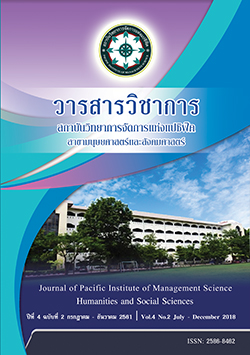The Policy to Promote Safety in Public Transport: A Case Study of Passengers Wearing A Seat Belt in Public Van, Bangkok Bus Terminal
Keywords:
safety policy, behavior of wearing seat beltsAbstract
The objectives of this research were 1) To study the problem of implementing the safety policy of wearing seat belt in the Land Transport Supervision Division. 2) To study behavior of passengers wearing a seat belt in Bangkok Bus Terminal area. 3) To provide guidance on the implementation of the safety policy of wearing seat belts in the Land Transport Supervision Division. Qualitative and quantitative methodologies were implemented in this paper. In qualitative approach, information was collected through interview. 8 samples were from the Land Transport Supervision Division, by using a purposive sampling technique. Then the information was analyzed descriptively. In quantitative method, 400 Samples were from passengers commuting the public van. Questionnaires were used to collect data. Statistically, mean, percentage and standard deviation are computed. T-test and One-way ANOVA were used to test the hypotheses given. Fisher’s Least Significant Difference (LSD) was further scrutinized in case of any statistically significant differences.
The research indicated that 1) Personal issue, public relations, operations and public participations effect on the achievement of implementing the seat belt policy in the Land Transport Supervision Division. 2) Most of passengers had the awareness level on benefit recognitions of wearing seat belt and severities of having an accident at the highest level. The behavioral level of passengers wearing a seat belt were at appropriate level. 3) The hypotheses testing found the behavioral level of wearing seat belts in public van with different age, monthly income and beneficial recognitions of wearing seat belt were statistically significant difference at 0.05 level. Beneficial recognitions on severities of having an accident was statistically significant difference at 0.01 level. There was no statistically significant difference in sex, education and road accidental experience.
Recommendations. 1) The public sector must have a continuous public relations policy regarding the use of seat belts and traffic law in various medias accessibly. 2) Schools should have a process of creating attitudes and values to promote decent behaviors of using seat belt. 3) Officials should tighten passengers in using seat belts rigorously. By increasing the number of checkpoints and inspective duration for continuity in practice. 4) Should have a continuously integration with officials from other agencies in order to enhance the work efficiency.
References
ประสาร มาลากุล ณ อยุธยา และคณะ. (2527). รูปแบบการพัฒนาทัศนคติต่อการประหยัดพลังงาน. กรุงเทพฯ: โรงพิมพ์จุฬาลงกรณ์มหาวิทยาลัย.
พาชื่น ภาณุพินทุ, พันตำรวจโท. (2542). การวิจัยสำรวจความคิดเห็นและพฤติกรรมผู้ใช้เข็มขัดนิรภัยของผู้ขับขี่รถยนต์ ในเขตเทศบาลเมืองจันทบุรี. วิทยานิพนธ์ปริญญารัฐประศาสนศาสตรมหาบัณฑิต. สาขาวิชานโยบายสาธารณะ. มหาวิทยาลัยบูรพา.
มนวดี ประกายรุ้งทอง. (2542). ความสัมพันธ์ระหว่างแบบแผนความเชื่อด้านสุขภาพกับพฤติกรรมการใช้เข็มขัดนิรภัยของผู้ขับรถยนต์ส่วนบุคคลในเขตกรมการขนส่งทางบก กรุงเทพมหานคร. วิทยานิพนธ์ปริญญาการศึกษามหาบัณฑิต. วิชาเอกสุขศึกษา. มหาวิทยาลัยศรีนครินทรวิโรฒ.
เสริมศักดิ์ วิศาลากรณ์ และคนอื่น ๆ. (2537). เข็มขัดนิรภัย ความเชื่อ ทัศนคติ และการใช้. กรุงเทพฯ: มหาวิทยาลัยศรีนคริทรวิโรฒ ประสานมิตร.
โสภิตสุดา มงคลเกษม. (2539). พฤติกรรมการเปิดรับข่าวสาร ความรู้ ทัศนคติและพฤติกรรมการคาดเข็มขัดนิรภัยของผู้ขับขี่รถยนต์ ในกรุงเทพมหานคร. วิทยานิพนธ์ปริญญานิเทศศาสตรมหาบัณฑิต. ภาควิชาการประชาสัมพันธ์. จุฬาลงกรณ์มหาวิทยาลัย.
อำพร ปัญญาสืบ. (2558). การนำนโยบายส่งเสริมความปลอดภัยในรถโดยสารสาธารณะไปปฏิบัติ กรณีศึกษา:การส่งเสริมการคาดเข็มขัดนิรภัยของผู้โดยสารของสำนักงานขนส่งจังหวัดพะเยา. การศึกษาค้นคว้าด้วยตนเองปริญญารัฐประศาสนศาสตรมหาบัณฑิต. สาขาวิชานโยบายสาธารณะ. ของมหาวิทยาลัยพะเยา.
Bloom, B.S. (1976). Human Characteristics and School Learning. New York: McGraw-Hill Book Company, Inc.
Cochran, W.G. (1963). Sampling Techniques. Wiley, New York.
Fhaner, G., & Hane, M. (1974). Seat belts: Relations between beliefs, attitude, and use. Journal of Applied Psychology, 59(4), pp. 472-482.
Schiffman, L. G., & Kanuk, L. L. (2007). Consumer behavior 9th ed. Upper Saddle River, N.J.: Pearson/Prentice Hall.
Downloads
Published
Issue
Section
License
บทความที่ได้รับการตีพิมพ์เป็นลิขสิทธิ์ของ สถาบันวิทยาการจัดการแห่งแปซิฟิค
ข้อความที่ปรากฏในบทความแต่ละเรื่องในวารสารวิชาการเล่มนี้เป็นความคิดเห็นส่วนตัวของผู้เขียนแต่ละท่านไม่เกี่ยวข้องกับสถาบันวิทยาการจัดการแห่งแปซิฟิค และคณาจารย์ท่านอื่นๆในสถาบันฯ แต่อย่างใด ความรับผิดชอบองค์ประกอบทั้งหมดของบทความแต่ละเรื่องเป็นของผู้เขียนแต่ละท่าน หากมีความผิดพลาดใดๆ ผู้เขียนแต่ละท่านจะรับผิดชอบบทความของตนเองแต่ผู้เดียว







